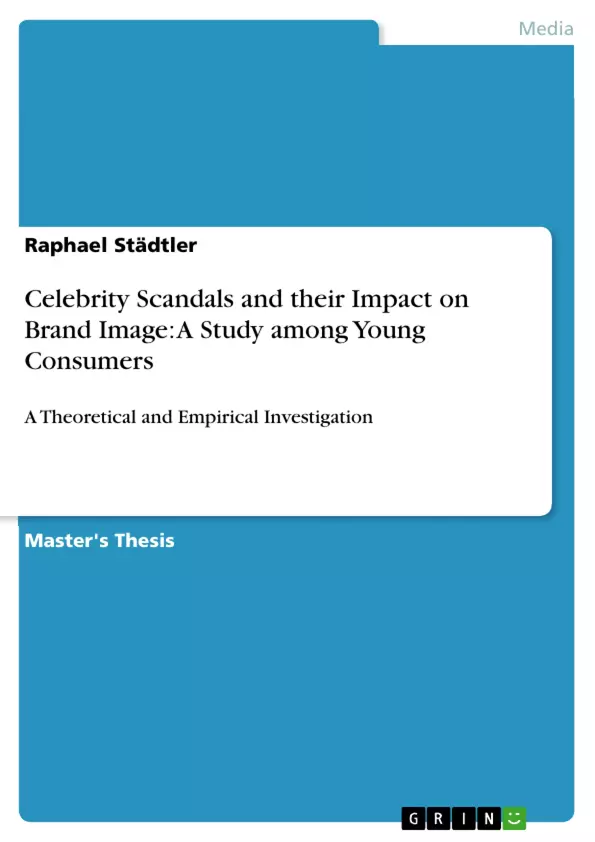Celebrity endorsements can be seen as a powerful and effective advertisement tool to cut through today’s thick media clutter, grab the attention of consumers by underpinning a brand’s image. The use of celebrities as a spokesperson for products and brands has been steadily increasing over the past decades. Celebrity Endorsements are perceived as a ubiquitous feature of modern marketing. Especially young consumers, who are considered to be brand conscious as well as regarded to idolise their favourite celebrities are a prime target of celebrity endorsements. Despite the many benefits celebrity endorsements entail, companies must also be aware of the potential drawbacks it brings along. Particularly celebrity endorser scandals are perceived to have an impact on a brand’s image. Owing to the steady growth of celebrity endorsements as an effective advertisement tool to boost a brand’s image, and to the fact that young consumers will remain the prime target of celebrity endorsements, this dissertation aims at investigating the impact of celebrity scandals on the brand image perception of young consumers. Based on a critical literature review, the author develops a conceptual and theoretical framework, in which this dissertation is set. An empirical study by means of an online survey distributed among 222 participants was conducted. Findings demonstrate that the brand image is hardly affected due to celebrity endorser scandals. However, the findings also reveal that felonies such as murder may lead to instant termination of consumption of a brand. The results of this research study provide some novel and useful insights into celebrity scandals and their impact on brands image, which can be used as guidelines for practitioners and as a starting point for further research.
Table of Contents
- Introduction
- Problem Statement and Disposition of the Paper
- Background and Importance of the Topic
- Branding
- What is a Product?
- What is Branding?
- The Importance of Strong Brands
- Brand Equity
- Building a Strong Brand: The CBBE Model
- Brand Building Implications: The CBBE Model
- Brand Image
- Brands and Young Consumers
- Celebrity Endorsements
- What is a Celebrity?
- What is Celebrity Endorsement?
- Celebrity Endorsement as an Effective Advertising Tool to Boost Brand Image
- Celebrity Endorser Selection
- Celebrity Endorsement Selection Models
- Source Credibility Model
- Source Attractiveness Model
- Match-Up Hypothesis
- Co-Activation Theory
- Implications and Limitations of Models
- Celebrity Endorser Scandals: Drawback or Boost for the Brand Image…
- Celebrity Scandals and their Impact on Young Consumers
- Methodology
- Introduction
- Research Objective
- Research Approach to Empirical Study
- Data Collection
- Quantitative Research
- Complications with Questionnaires
- Assessing Validity
- Reliability Testing
- Questionnaire Design
- Pilot Study
- Sample Group and Execution of the Study
- Data Analysis
- Limitations
- Data Analysis and Findings
- Survey Results
- Socio-Demographic Factors
- Brands and Young Consumers
- Celebrity Endorsements
- Kate Moss Incident
- Discussion of Results
- Conclusion and Future Work…
- Limitations and Future Research
Objectives and Key Themes
This dissertation investigates the impact of celebrity scandals on the brand image perception of young consumers. It aims to understand how these scandals affect a brand's image and whether they lead to a decline in consumer trust and brand loyalty. The research aims to provide insights for practitioners and a starting point for further research.
- Celebrity endorsements and their impact on brand image
- The influence of celebrity scandals on young consumers' brand perceptions
- The relationship between celebrity endorser scandals and consumer behavior
- The development of a theoretical framework to understand celebrity scandals and brand image
- The implications of research findings for marketing practitioners and future research
Chapter Summaries
The first chapter introduces the problem statement and the importance of the topic. It highlights the increasing use of celebrity endorsements and the potential impact of scandals on brand image, particularly among young consumers. The second chapter focuses on branding, exploring the concepts of product, branding, brand equity, and brand image. It examines the importance of strong brands and the specific characteristics of brands targeting young consumers. The third chapter delves into celebrity endorsements, defining the term and discussing its effectiveness as an advertising tool. It examines the different models used for celebrity endorser selection, including source credibility, source attractiveness, and the match-up hypothesis. This chapter also explores the potential drawbacks of celebrity endorsements, specifically focusing on celebrity scandals and their impact on young consumers.
The fourth chapter outlines the methodology used for the empirical study. It details the research objective, research approach, data collection methods, and data analysis techniques. The chapter also discusses the limitations of the study. The fifth chapter presents the findings of the empirical study, analyzing the survey results and discussing the impact of celebrity scandals on brand image. The chapter examines the relationship between different types of scandals and consumer behavior.
Keywords
This research focuses on celebrity endorsements, brand image, young consumers, celebrity scandals, and consumer behavior. It investigates the impact of negative publicity associated with celebrities on brand image perception. The research utilizes theoretical frameworks such as the CBBE model and source credibility, source attractiveness, and the match-up hypothesis models to understand the complex relationship between celebrities, brands, and consumers. The study explores the role of celebrity scandals in influencing consumer decision-making and the potential implications for marketing practitioners.
- Quote paper
- Raphael Städtler (Author), 2010, Celebrity Scandals and their Impact on Brand Image: A Study among Young Consumers , Munich, GRIN Verlag, https://www.grin.com/document/170577



